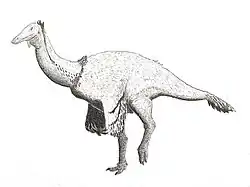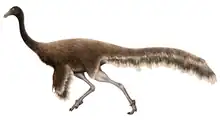Paraxenisaurus
Paraxenisaurus (meaning "strange lizard") is a genus of deinocheirid theropod dinosaur that lived in what is now Mexico during the Campanian stage of the Late Cretaceous Period, 73 to 72.1 million years ago.
| Paraxenisaurus Temporal range: Late Cretaceous, | |
|---|---|
 | |
| Diagram of the skeleton of the Mexican deinocheirid, Paraxenisaurus normalensis. Found bones are shown in white, although some bones do not appear as the illustration is in side view. | |
| Scientific classification | |
| Domain: | Eukaryota |
| Kingdom: | Animalia |
| Phylum: | Chordata |
| Clade: | Dinosauria |
| Clade: | Saurischia |
| Clade: | Theropoda |
| Clade: | †Ornithomimosauria |
| Family: | †Deinocheiridae |
| Genus: | †Paraxenisaurus Serrano-Brañas et al., 2020 |
| Species: | †P. normalensis |
| Binomial name | |
| †Paraxenisaurus normalensis Serrano-Brañas et al., 2020 | |
Discovery and naming
During the 1990s, ornithomimosaur fossils were discovered at three sites in the Cerro del Pueblo Formation of Coahuila state. Two decades later, these remains were identified as belonging to a distinct North American taxon. In 2020, they were named and described by Mexican paleontologists Claudia Inés Serrano-Brañas, Belinda Espinosa-Chávez, Sarah Augusta Maccracken, Cirene Gutiérrez-Blando, Claudio de León-Dávila and José Flores Ventura. The type species Paraxenisaurus normalensis. The generic name is derived from the Greek paráxenos, "strange". The specific name is after the Benemérita Escuela Normal de Coahuila, a teacher training institution, where the fossils had been deposited. They include the holotype BENC 2/2-001, a partial skeleton lacking the skull. Four additional specimens were referred, from separate individuals. The material contains vertebrae of the backbone, as well as a thighbone, an astragalus and hand, most notably a manual claw, and foot elements.[1]

Description

Based on the fossil elements of the holotype, the specimen was an adult. The length of Paraxenisaurus has been estimated at 5.7 metres (19 ft), and its weight at 600 kilograms (1,300 lb).[1]
Classification
A phylogenetic analysis recovered Paraxenisaurus as a member of the Deinocheiridae, in a polytomy with Deinocheirus and Garudimimus. It would then represent the first deinocheirid dinosaur found in North America.[1]
Paleoecology
Known from the Cerro del Pueblo Formation, Paraxenisaurus lived alongside Coahuilaceratops, Latirhinus, and Velafrons, and other undescribed ornithomimosaurs. This area was most likely a coastal plain during the Late Cretaceous.
References
- Claudia Inés Serrano-Brañas; Belinda Espinosa-Chávez; S. Augusta Maccracken; Cirene Gutiérrez-Blando; Claudio de León-Dávila; José Flores Ventura (2020). "Paraxenisaurus normalensis, a large deinocheirid ornithomimosaur from the Cerro del Pueblo Formation (Upper Cretaceous), Coahuila, Mexico". Journal of South American Earth Sciences. 101: Article 102610. doi:10.1016/j.jsames.2020.102610.

.jpg.webp)












